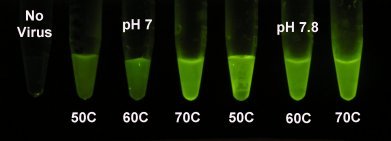PBCV stability
Sybr Gold stains PBCV. Interestingly 10min at 70C enhances the fluorescence. The enhancement is most easily interpreted is virus disruption which releases DNA into solution. The enhanced fluorescence could result from increased dye binding, decreased quenching, etc. In any case degree of fluorescence is presumably a measure of virion stability.
Adapting the assay to lower pHs is complicated by the instability of Sybr Gold below pH 7. This is readily overcome by adding tris and Sybr Gold following heat treatment.
All samples except pH 7.8 (tris buffer) contained 25mM potassium ion. The apparent lesser stability of the tris sample likely reflects the tris cation rather than pH. The pKa of tris depends strongly on temperature. At 50C and 60C, pH of the "7.8" samples is likely less than that of the pH 7 samples (potassium MOPS buffer). Clearly PBCV-1 is very stable at lower pHs, at least down to 4.5.

